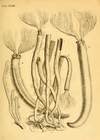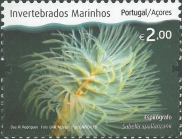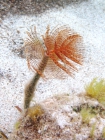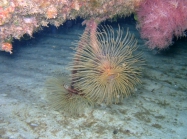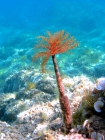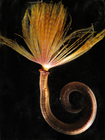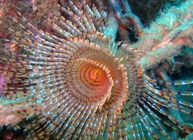
| Introduction | | Search taxa | | Taxon tree | | Taxon match | | Checklist | | Literature | | Stats | | Photogallery | | OBIS Vocab | | Log in |
CaRMS taxon detailsSabella Linnaeus, 1767
129549 (urn:lsid:marinespecies.org:taxname:129549)
accepted
Genus
marine,
recent only
feminine
Linnaeus, C. (1767). Systema naturae per regna tria naturae: secundum classes, ordines, genera, species, cum characteribus, differentiis, synonymis, locis. Ed. 12. 1., Regnum Animale. 1 & 2. <em>Holmiae [Stockholm], Laurentii Salvii.</em> pp. 1-532 [1766] pp. 533-1327 [1767]., available online at http://www.biodiversitylibrary.org/item/83650#5
page(s): 1268 [details]
Note Linnaeus (1767:1268-9) included 7 species in...
From editor or global species database
Type species Linnaeus (1767:1268-9) included 7 species in Sabella, of which the last was Serpula penicillus Linnaeus 1758. As Serpula penicillus (recombined as Sabella) is the only remaining valid taxon of those included by Linnaeus (1767) it must be the only possible type, but the question is what species was it? Linnaeus (1758: 788) had based it on a species from Malta described by Ellis 1755: 92, plate 34. This is clearly what is now called Sabella spallanzanii and is not Sabella pavonina. Hartman catalogue (1959: 557) designates the Linnaean 'penicillus' as the type of the genusKnight-Jones & Perkins (1998):391 discuss whether the errors in spelling and authority in the subsequent designation of a type species by Chenu (1859) are fatal to regarding that designation (of Sabella penicillus Savigny) as the first type designation. They point out that that Savigny's and Chenu's usages of "Sabella penicillus" from the Channel are probably S. pavonina, and if new and not usages of the Linnaeus name, are therefore a junior homonym. Thus (Editor's view) the designation by Chenu is wrong and an irrelevant side issue. Type species as "Sabella penicillus Linnaeus 1767" as in Fauchald, 1977:140 is incorrect for genus (originally in Serpula) and date (originally 1758), but is derivative of the original name. [details]
Etymology According to Brown (1954:679) Sabella, as in Sabella penicillus, comes from Latin sabellum, neuter, a diminutive (he...
Etymology According to Brown (1954:679) Sabella, as in Sabella penicillus, comes from Latin sabellum, neuter, a diminutive (he claims) of sabulum, neuter, meaning coarse sand. Likewise Houttuyn (1771:607 [https://biodiversitylibrary.org/page/45235809] derives Sabella from sabulum meaning sand because the worms (translation) "make their homes out of sand or gravel"). However, the spelling and Latin dictionaries does not support this and in any case the tubes are not made of 'sand' as such, and certainly not gravel. Linnaeus, and especially later Gmelin in Linnaeus, 1788, appear to treat Sabella as feminine when they formed names. As the spelling differs and the gender was probably intended to be feminine, it is equally likely derived from a personal name of Roman times, than derived from a word for sand, as Sabella was the nurse of the Latin poet Horace (see Bibliotheca Classica of John Lemprière), and Sabellus was another Latin poet, and Sabelli was a name for the Sabine people of Italy. However, the coincidence of a possible link to a sandy habitat or tube composition can be mentioned also, despite the spelling difference. Users can choose their own preference of derivation, as we cannot know for sure. [details] Taxonomy Early checklists. Grube (1850: 336) has a checklist of Sabella species by 1850. Grube has short details of the works in...
Taxonomy Early checklists. Grube (1850: 336) has a checklist of Sabella species by 1850. Grube has short details of the works in which the names were published, and the list shows how certain names such as Spirographis spallanzanii were treated at the time. Quatrefages (1866:432- ) has a long section on Sabella names, with his treatment and comments on them, and descriptions. [details]
Read, G.; Fauchald, K. (Ed.) (2024). World Polychaeta Database. Sabella Linnaeus, 1767. Accessed through: Nozères, C., Kennedy, M.K. (Eds.) (2024) Canadian Register of Marine Species at: https://marinespecies.org/carms/aphia.php?p=taxdetails&id=129549 on 2024-04-20
Nozères, C., Kennedy, M.K. (Eds.) (2024). Canadian Register of Marine Species. Sabella Linnaeus, 1767. Accessed at: https://marinespecies.org/carms/aphia.php?p=taxdetails&id=129549 on 2024-04-20
Date action by
original description
Linnaeus, C. (1767). Systema naturae per regna tria naturae: secundum classes, ordines, genera, species, cum characteribus, differentiis, synonymis, locis. Ed. 12. 1., Regnum Animale. 1 & 2. <em>Holmiae [Stockholm], Laurentii Salvii.</em> pp. 1-532 [1766] pp. 533-1327 [1767]., available online at http://www.biodiversitylibrary.org/item/83650#5
page(s): 1268 [details] taxonomy source Grube, Adolf Eduard. (1850). Die Familien der Anneliden. <em>Archiv für Naturgeschichte, Berlin.</em> 16(1): 249-364., available online at https://biodiversitylibrary.org/page/6958350 page(s): 336; note: Grube checklist of Sabella species by 1850. Grube has short details of the works in which the names were published, and the list shows how certain names such as Spirographis spallanzanii were treated ... Grube checklist of Sabella species by 1850. Grube has short details of the works in which the names were published, and the list shows how certain names such as Spirographis spallanzanii were treated at the time. taxonomy source Quatrefages, A. (1866). Histoire naturelle des Annelés marins et d'eau douce. Annélides et Géphyriens. <b>Volume 2.</b>. Première partie. 1-336. Deuxième Partie. 337-794. Explication des planches p.1-24. planches 1-20. Librarie Encyclopédique de Roret. Paris., available online at http://books.google.com/books?id=M_xNAAAAcAAJ page(s): 432; note: Quatrefages (1866:432- ) has a long section on Sabella names, with his treatment and comments on them, and descriptions. [details] context source (Hexacorallia) Fautin, Daphne G. (2013). Hexacorallians of the World. (look up in IMIS) [details] additional source Fauchald, K. (1977). The polychaete worms, definitions and keys to the orders, families and genera. <em>Natural History Museum of Los Angeles County: Los Angeles, CA (USA), Science Series.</em> 28:1-188., available online at http://www.vliz.be/imisdocs/publications/123110.pdf [details] additional source Bellan, G. (2001). Polychaeta, <i>in</i>: Costello, M.J. <i>et al.</i> (Ed.) (2001). European register of marine species: a check-list of the marine species in Europe and a bibliography of guides to their identification. <em>Collection Patrimoines Naturels.</em> 50: 214-231. (look up in IMIS) [details] additional source Day, J. H. (1967). [Sedentaria] A monograph on the Polychaeta of Southern Africa. Part 2. Sedentaria. British Museum (Natural History), London. pp. 459–842., available online at http://www.biodiversitylibrary.org/bibliography/8596 [details] redescription Knight-Jones, Phyllis; Perkins, Thomas H. (1998). A revision of Sabella, Bispira and Stylomma (Polychaeta: Sabellidae). <em>Zoological Journal of the Linnean Society, London.</em> 123: 385-467., available online at https://doi.org/10.1111/j.1096-3642.1998.tb01370.x [details] Available for editors  Present Present  Inaccurate Inaccurate  Introduced: alien Introduced: alien  Containing type locality Containing type locality
From editor or global species database
Etymology According to Brown (1954:679) Sabella, as in Sabella penicillus, comes from Latin sabellum, neuter, a diminutive (he claims) of sabulum, neuter, meaning coarse sand. Likewise Houttuyn (1771:607 [https://biodiversitylibrary.org/page/45235809] derives Sabella from sabulum meaning sand because the worms (translation) "make their homes out of sand or gravel"). However, the spelling and Latin dictionaries does not support this and in any case the tubes are not made of 'sand' as such, and certainly not gravel. Linnaeus, and especially later Gmelin in Linnaeus, 1788, appear to treat Sabella as feminine when they formed names. As the spelling differs and the gender was probably intended to be feminine, it is equally likely derived from a personal name of Roman times, than derived from a word for sand, as Sabella was the nurse of the Latin poet Horace (see Bibliotheca Classica of John Lemprière), and Sabellus was another Latin poet, and Sabelli was a name for the Sabine people of Italy. However, the coincidence of a possible link to a sandy habitat or tube composition can be mentioned also, despite the spelling difference. Users can choose their own preference of derivation, as we cannot know for sure. [details]Grammatical gender Feminine, based on treatment by authors of the time and the existence of Sabella as a female personal name. [details] Taxonomy Early checklists. Grube (1850: 336) has a checklist of Sabella species by 1850. Grube has short details of the works in which the names were published, and the list shows how certain names such as Spirographis spallanzanii were treated at the time. Quatrefages (1866:432- ) has a long section on Sabella names, with his treatment and comments on them, and descriptions. [details] Type species Linnaeus (1767:1268-9) included 7 species in Sabella, of which the last was Serpula penicillus Linnaeus 1758. As Serpula penicillus (recombined as Sabella) is the only remaining valid taxon of those included by Linnaeus (1767) it must be the only possible type, but the question is what species was it? Linnaeus (1758: 788) had based it on a species from Malta described by Ellis 1755: 92, plate 34. This is clearly what is now called Sabella spallanzanii and is not Sabella pavonina. Hartman catalogue (1959: 557) designates the Linnaean 'penicillus' as the type of the genus Knight-Jones & Perkins (1998):391 discuss whether the errors in spelling and authority in the subsequent designation of a type species by Chenu (1859) are fatal to regarding that designation (of Sabella penicillus Savigny) as the first type designation. They point out that that Savigny's and Chenu's usages of "Sabella penicillus" from the Channel are probably S. pavonina, and if new and not usages of the Linnaeus name, are therefore a junior homonym. Thus (Editor's view) the designation by Chenu is wrong and an irrelevant side issue. Type species as "Sabella penicillus Linnaeus 1767" as in Fauchald, 1977:140 is incorrect for genus (originally in Serpula) and date (originally 1758), but is derivative of the original name. [details] |

